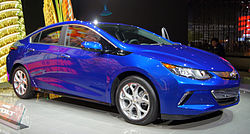Plug-in hybrid

A plug-in hybrid car is similar to a conventional hybrid vehicle—both use a gasoline engine as well as an electric motor. A plug-in hybrid differs primarily in that it can be plugged in to charge the batteries, while a conventional hybrid relies solely on energy generated from braking, coasting or from the gasoline engine.
A plug-in hybrid uses larger battery packs that can be recharged by connecting to common household electricity. Plug-in hybrids can be driven for long distances—from a few miles to as much as 40 miles—without using any gasoline. Plug-in hybrid cars are also known as plug-in hybrid electric vehicles or PHEVs. Plug-in hybrid cars that use a gas engine exclusively for recharging batteries—rather than directly powering the wheels—are also called Extended-Range Electric Vehicles or E-REVs.
Fueling a car with electricity is about 5 times cheaper than fueling it with gasoline. That is equivalent to buying gasoline at less than $1 per gallon. It also reduces greenhouse pollution and helps reduce crude oil imports. Also plug-in hybrids produced substantially lower greenhouse gas emissions than either conventional gasoline cars or unplugged hybrids.
Criticisms
Criticisms of the hybrid include the additional cost, weight, and size of a larger battery pack.
Manufacturing (year 2024 and/or 2025)
BYD made [c. 2.5 million or] 2,503,119 plug-in hybrid vehicles (year 2024).[1]
Brands that made plug-in hybrids in 2024, include
- Audi, Audi A3, A8, Q5, Q7 (year 2024)
- Baojun Yunhai
- Bentley Bentayga
- BMW M5, BMW XM
- BYD, including BYD Shark
- Citroën C5 X
- Fangchengbao Bao 8
- Ford Ranger (T6), Ford Escape
- Honda CR-V
- Hyundai Sonata
- Jeep Renegade, Jeep Wrangler
- Karma Revero
- Lamborghini Urus SE (2024)
- Mercedes-Benz, including Mercedes-Benz GLE
- Mitsubishi Outlander
- Peugeot 508
- Porsche Panamera
- Renault Captur, its length is 4.05 m
- Seat made SEAT León (2024)
- Škoda, including Škoda Superb
- Tank, including Tank 700
- Toyota RAV4
- Volkswagen; Golf Mk8, Passat B9, Tiguan, Tayron, Touareg
- Volvo, including Volvo XC40, Volvo XC90, Volvo S60
- Voyah, including Voyah Free
- Wey, including Wey VV7
- Yangwang, including Yangwang U8
Plug-in Hybrid Media
The Lohner–Porsche Mixte Hybrid was the first gasoline-electric plug-in hybrid automobile.
Lithium-ion battery pack, with cover removed, in a CalCars "PRIUS+" plug-in hybrid converted Toyota Prius converted by EnergyCS
Three plug-in converted Toyota Prius recharging at San Francisco City Hall public charging station
The Toyota Prius Plug-in Hybrid was launched in Japan and the U.S. in early 2012, and Europe by mid-2012.
The Chevrolet Volt operates primarily as a series hybrid.
The Honda CR-V e:FCEV is a plug-in hybrid that pairs a battery, an electric motor, hydrogen tank and a fuel cell.
15 lead–acid batteries, PFC charger, and regulators installed into WhiteBird, a PHEV-10 conversion of a Toyota Prius
All-electric range, in miles, for several popular model year 2013 plug-in hybrids, as observed in testing by Popular Mechanics magazine. Providing greater all-electric range adds cost and entails compromises, so different all-electric ranges may suit different customers' needs.
The Chevrolet Volt was the world's top selling plug-in hybrid until September 2018.
| Wikimedia Commons has media related to Lua error in Module:Commons_link at line 62: attempt to index field 'wikibase' (a nil value).. |









